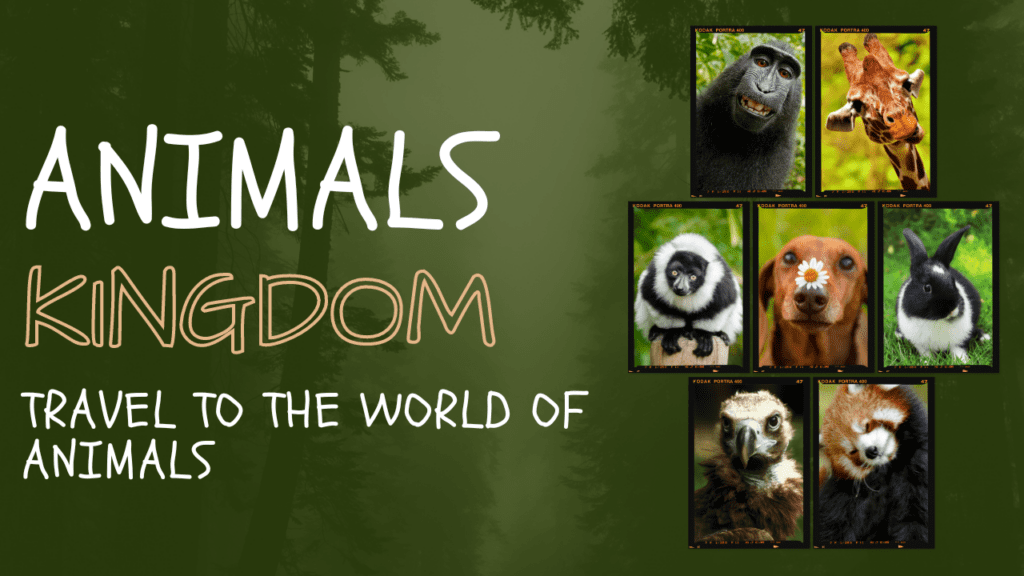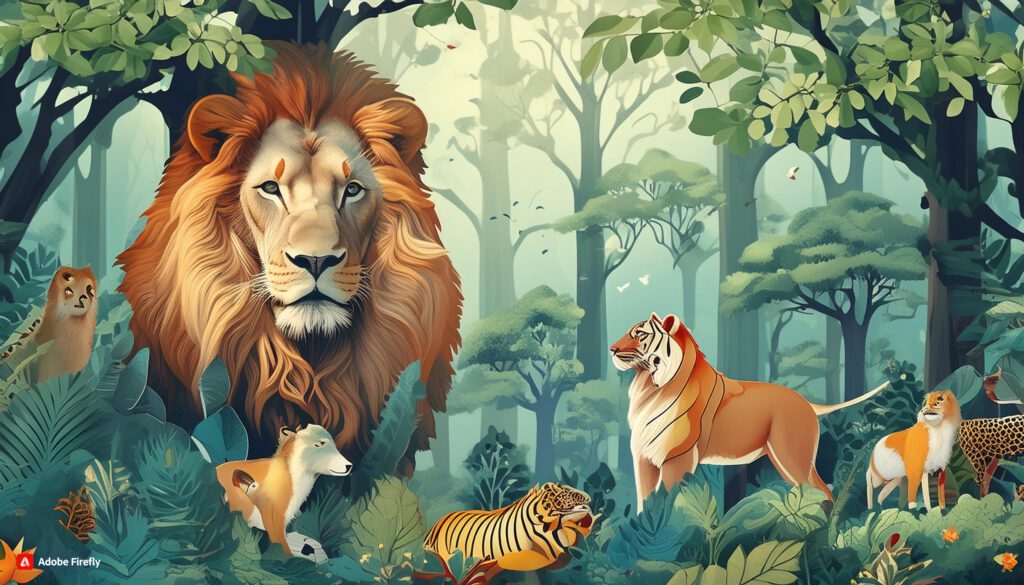Animals Kingdom A life Of Animals
1. Introduction Animals Kingdom
The animal kingdom is an incredibly diverse realm, home to millions of species ranging from tiny insects to massive mammals. This diversity is a result of millions of years of evolution, during which animals have adapted to a wide range of environments. Studying and understanding animals is crucial because it helps us appreciate the complexity of life on Earth, understand our own origins, and work towards preserving the delicate balance of ecosystems.


2. Classification of Animals in Animals Kingdom
Animals can be divided into two main groups: vertebrates and invertebrates.
Vertebrates:
- Mammals: Warm-blooded animals with hair or fur. Most give birth to live young. Examples include humans, lions, and whales.
- Birds: Warm-blooded creatures with feathers and wings. They lay eggs. Examples are eagles, penguins, and sparrows.
- Reptiles: Cold-blooded animals with scales. They lay eggs or give birth to live young. Examples include snakes, lizards, and turtles.
- Amphibians: Cold-blooded animals that live both in water and on land. Examples are frogs, salamanders, and newts. .
- Fish: Cold-blooded animals that live in water and breathe through gills. Examples include salmon, sharks, and goldfish.
Invertebrates:
- Insects: The largest group of animals. Examples include beetles, butterflies, and ants.
- Arachnids: Eight-legged creatures such as spiders, scorpions, and ticks.
- Mollusks: Soft-bodied animals, often with shells. Examples include snails, clams, and octopuses.
- Crustaceans: Mostly aquatic animals with hard shells. Examples are crabs, lobsters, and shrimp.
Table 1: Classification of Vertebrates and Invertebrates
| Vertebrates | Examples | Invertebrates | Examples |
| Mammals | Humans, Lions, Whales | Insects | Beetles, Butterflies, Ants |
| Birds | Eagles, Penguins, Sparrows | Arachnids | Spiders, Scorpions, Ticks |
| Reptiles | Snakes, Lizards, Turtles | Mollusks | Snails, Clams, Octopuses |
| Amphibians | Frogs, Salamanders, Newts | Crustaceans | Crabs, Lobsters, Shrimp |
| Fish | Salmon, Sharks, Goldfish |
3. Habitats and Adaptations
Animals have adapted to live in various environments:
- Aquatic Habitats: Marine animals like dolphins and coral reefs, and freshwater species like frogs and trout.
- Terrestrial Habitats: Forest dwellers like tigers and monkeys, desert inhabitants like camels and meerkats.
- Aerial Habitats: Birds and bats have evolved to live in the skies.
- Extreme Environments: Polar animals like penguins and polar bears, deep-sea creatures like anglerfish. .
Table 2: Animal Habitats and Examples
| Habitat Type | Examples |
| Aquatic | Dolphins, Coral Reefs, Frogs, Trout |
| Terrestrial | Tigers, Monkeys, Camels, Meerkats |
| Aerial | Eagles, Bats |
| Extreme Environments | Penguins, Polar Bears, Anglerfish |
Adaptations:
- Camouflage: Animals like chameleons and certain insects can change color to blend in with their surroundings.
- Hibernation: Bears and some rodents enter a state of deep sleep during winter to conserve energy.
- Migration: Birds, whales, and some fish travel long distances to find food or breeding grounds.
- Nocturnality: Animals like owls and bats are active at night to avoid predators and heat.
4. Behaviors and Social Structures
Animals display a wide range of behaviors and social structures:
- Migration: Animals like monarch butterflies and humpback whales migrate vast distances for breeding or food.
- Communication: Animals use sounds, gestures, and chemical signals. Bees, for example, perform dances to convey information about food sources.
- Social Hierarchies: Species such as wolves and elephants live in structured social groups with defined roles.
- Mating Rituals: These can be elaborate, like the dances of birds of paradise or the loud calls of frogs.
Table 3: Animal Behaviors and Examples
| Behavior | Examples |
| Migration | Monarch Butterflies, Humpback Whales |
| Communication | Bees (dances), Dolphins (clicks and whistles) |
| Social Hierarchies | Wolves (packs), Elephants (herds) |
| Mating Rituals | Birds of Paradise (dances), Frogs (calls) |
5. Roles in Ecosystems in Animals Kingdom
Animals play vital roles in ecosystems:
- Pollinators: Insects like bees and butterflies are essential for pollinating plants.
- Predators and Prey: They help maintain population balance and contribute to the food web.
- Decomposers: Species like earthworms and fungi break down dead material, recycling nutrients.
- Keystone Species: Certain animals, such as beavers and elephants, have a significant impact on their environment, shaping habitats and influencing biodiversity.
Table 4: Roles of Animals in Ecosystems
| Role | Examples |
| Pollinators | Bees, Butterflies |
| Predators | Lions, Eagles |
| Prey | Deer, Fish |
| Decomposers | Earthworms, Fungi |
| Keystone Species | Beavers (dams), Elephants (habitat shaping) |
6. Conservation and Threats
Many animal species are threatened by human activities, necessitating conservation efforts:
- Habitat Destruction: Deforestation, urbanization, and agriculture destroy animal habitats.
- Climate Change: Alters habitats and food sources, affecting animal survival.
- Poaching and Hunting: Illegal hunting for fur, tusks, and other body parts.
- Pollution: Contaminates habitats and food sources, leading to health issues and death.
Table 5: Conservation Threats and Effects
| Threat | Effect on Animals |
| Habitat Destruction | Loss of habitat, reduced biodiversity |
| Climate Change | Alter |
ed habitats, disrupted food sources | | Poaching | Population decline, endangered species | | Pollution | Health issues, habitat contamination |
7. Conclusion Of The Animals Kingdom
The astonishing diversity and adaptability of life on Earth are exemplified by the animal world.Understanding and appreciating the roles animals play can help us protect them and ensure the health of our planet. Conservation efforts are vital to preserving the delicate balance of ecosystems and the myriad of species that inhabit them.
8. Fun Facts (Animals Kingdom)






- A group of flamingos is called a “flamboyance.”
- Octopuses have three hearts and blue blood.
- Honey never spoils. Over 3,000-year-old, edible pots of honey have been discovered by archaeologists in Egyptian tombs.
- The heart of a shrimp is located in its head.
- Elephants are the only animals that can’t jump.
9. Human-Animal Interaction
- Historically, animals have played crucial roles in human culture, from being worshipped as gods to serving as pets and companions.
- In modern times, animals are integral to industries such as agriculture, entertainment, and therapy, showcasing the profound and multifaceted relationships between humans and animals.
- Animals like horses and dogs have been partners in human work and companionship for centuries.
- Zoos and wildlife sanctuaries play a role in educating the public and conserving endangered species.
FAQs About Animals Kingdom
A: Individuals can help by supporting conservation organizations, reducing their carbon footprint, avoiding products made from endangered animals, and spreading awareness about the importance of biodiversity.
